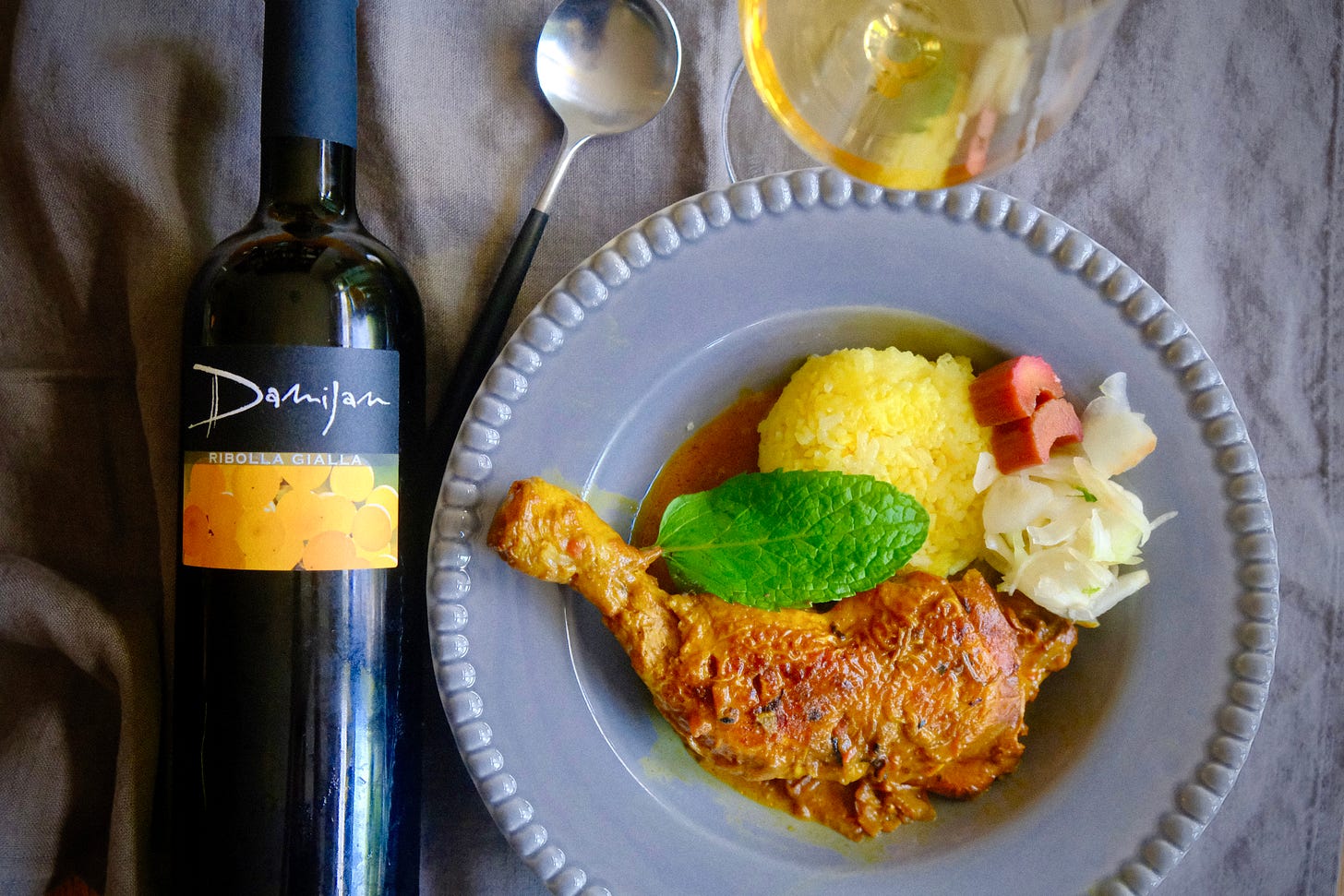Curry, Saffron & Noble Rot
Damijan Podversic Ribolla Gialla 2020 with a spice curry that turns sunshine into flavour
Summer Heat Along the Canal
The Netherlands has slipped into its brief, golden season, and along the canals of Amsterdam neighbours sprawl on improvised lawns and pocket‑sized sandbars, chasing the late light with bare feet and paper cones of kibbeling. The warmth—sometimes edging into real heat—triggers an olfactory chain reaction for me: hot sun calls for hot spice, and before long I find myself thinking of curry. Cardamom, garam masala, ground semi di coriandolo and a sly crack of cayenne turn temperature into flavour, the whole dish glowing amber once it meets a pinch of saffron in the rice. To stand shoulder to shoulder with that aromatic heat, I wanted a wine already carrying its own saffron thread, one forged by warmth and by time. That led me to Damijan Podversic Ribolla Gialla 2020.
A Wine Forged by Noble Rot and Patience
Damijan Podversic farms ten hectares on the terraces of Oslavia, hard against the Friuli‑Slovenia border. Apprenticed to Joško Gravner, he works without herbicides and relies on nothing more than minimal copper–sulphur in the vines. Yields rarely rise above forty quintals per hectare because bunches are ruthlessly thinned until only the ripest remain, and harvest waits until a touch of botrite nobile has crept across the fruit.
In the warm 2020 vintage roughly forty per cent of the Ribolla berries carried noble rot, setting the stage for a spell of slow transformation: sixty to ninety days of maceration on the skins, followed by three years in twenty‑ to thirty‑hectolitre botti and a further year of quiet settling in bottle. No stainless steel ever intrudes; clarification is achieved by time alone.
How Noble Rot Rewrites Flavour
The Botrytis cinerea fungus performs two feats at once. First, it dehydrates the berries, stripping out water so sugars, acids and every latent aromatic precursor become concentrated. Second, it floods the must with its own enzymes—pectinasi, laccasi, lipossigenasi among others—that clip terpene chains into a spray of orange‑marmalade scents, oxidise grape lipids into mushroom notes and polymerise polyphenols into deeper colour and nutty nuances.
Skins breached by the rot let oxygen seep in, so the dense must ferments slowly and warmly, allowing gentle Maillard reactions that ordinary dry whites would need years of bottle age to achieve. Long sur‑lie élevage (lees ageing) liberates mannoproteins, smoothing texture, while the neutral botti breathe just enough to weave a whisper of vanillin and toast into the aromatic fabric.
Tasting the 2020 Ribolla Gialla
The wine pours a luminous amber‑gold that seems to catch every stray beam of evening sun. At the first swirl the nose lifts white blossoms and crushed chalk before opening to apricot, yellow peach and the alpine freshness of mountain herbs. A patient minute later pine resin, candied orange peel and beeswax emerge, accompanied by a thread of sotolon that recalls saffron and curry leaf, and in the background a subtle woodland‑mushroom note born of the noble rot.
On the palate the wine feels medium‑full, its juicy, high acidity keeping it buoyant while tea‑fine tannins lend a tactile crunch, and the fourteen per cent alcohol reads as structure rather than weight. The finish stretches far beyond the last sip, lingering on bitter‑orange zest, salt‑lick minerality and a memory of dry mountain air.
Curry on the Stove, Wine in the Glass
My favourite pairing of the week began with chicken simmered in a sauce scented by cloves, cumin, ginger and garlic, with a late flutter of star anise, all spooned over rice stained gold with saffron threads. Marinated fennel seasoned only with salt, and a separate quick pickle of wine‑vinegared, sugared rhubarb added bright accents. The wine’s saffron‑marmalade register echoed the rice, its brisk acidity reset the palate between mouthfuls of spice‑laden sauce, its tannins found easy footing alongside the protein, and the saline tail underlined the curry’s savoury depth. The result felt less like wine versus food than two warm landscapes folding into one another.
Final Sip
When summer heat coaxes you outdoors and invites spice onto the plate, reach for a wine already shaped by its own brand of heat—sun, noble rot and a long maceration. Damijan Podversic Ribolla Gialla 2020 answers with amber colour, saffron perfume and a beeswax‑sleek texture, proving that “orange” wine can be both rustic and refined, perfectly at ease beside a bowl of curry on a canal‑side afternoon. I would love to hear which orange wines you have paired with spice‑driven dishes—triumphs and spectacular misfires alike—so drop your stories in the comments and let’s trade notes.
This is the short version—now shut the laptop, grab a bottle, and get yourself to the beach! Thanks for reading Pairing the World: Wine, Sake, and More!



